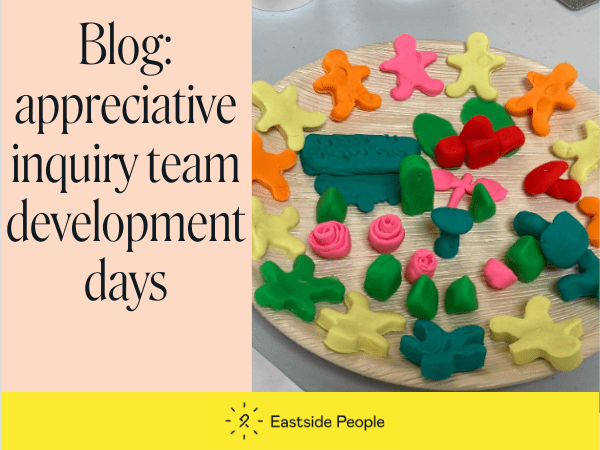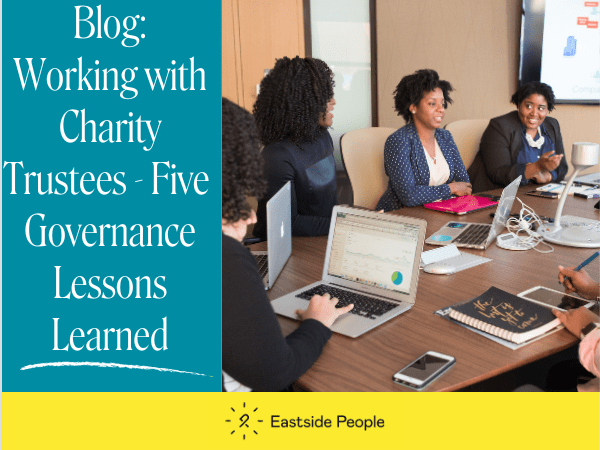Blog by Eastside People’s CEO Richard Litchfield.
During 2024, our consultants worked on hundreds of projects, helping charities build their capacity, enhance their sustainability and impact, find new partners, develop their skills and recruit brilliant board members and permanent senior staff.
However, we also worked with many charities that were struggling to survive, who came to us for advice on how they could continue to deliver vital services in today’s environment of increasing costs, a trend which sadly we predict continuing in 2025.
Read this blog to find out what I learned about ensuring charity survival through these difficult times.
A challenging outlook
High profile organisations like Children England and House of St Barnabas have recently closed their doors, as well as valuable infrastructure bodies like Getting on Board and Development Initiatives.
Not far behind these emergency cases are literally hundreds if not thousands of charities reporting concerns about their financial health. In the last twelve months, there has been an unprecedented rise in distressed charities with 32% anticipating a worsening financial situation according to research by Pro Bono Economics (NTU) and Nottingham Trent University. Local government budget cuts and recruitment challenges are cited as having a major impact, with as many as 1 in 5 charities being forced to cut back on the number or scope of services they offer as a result of rising costs.
In addition, the Charity Finance group has found that the impending impact of the increase in Employer National Insurance Contributions (ERNICS) and raising of the minimum wage are causing ‘very to moderate’ levels of concern in eight in ten charities (84%) with 87% also concerned about their organisation’s ability to absorb the changes under their current operating and financial models.
Over 7,300 charities signed ACEVO and NCVO’s letter to the Chancellor raising concerns about these changes. While Rachel Reeves acknowledged the vital contribution that civil society makes, she reiterated the scale of the challenge ahead for the government, and said that the decision could not be changed. She has, however, promised to ‘reset the relationship with civil society and build a new partnership to harness the full potential’ by developing a Civil Society Covenant, recognising the sector as a trusted and independent partner. We look forward to monitoring progress on this vital initiative.
Lessons learned and recommendations for moving forwards
When times are difficult there is no point in flannel. On the contrary, dispassionate and clear-headed thinking can lead to creative change – “necessity is the mother of invention” after all.
So, this is for all Trustees, Chairs, CEOs, and Charity Managers facing difficult financial times – and what I’ve learnt needs to be done.
How urgent is your situation?
The first action to take is to understand what the problem is and what are the contours of your financial circumstances. How urgent is the situation?
You need to understand the picture for your business model (revenue/income position) and reserves (i.e. cash position):
- Quite simply is your business model screwed? This occurs when there are not enough donors, commissioners, funders or trading customers willing to pay for the full cost of the services that your charity is providing. This is the revenue/income part.
- How low are your cash reserves? You may have found that reserves have been falling over time and cover increasingly smaller number of weeks of overheads. Low reserves translate into less time to respond.
Bad luck
A weak business model and low reserves are the basic diagnostics that tell us if a charity is moving from ill-health to the emergency room. Typically, though, lady luck has the final say. The final straw invariably comes from unrelated events that knock a struggling charity over the precipice.
Whether it’s a key person leaving the organization, a major contract being lost, a data breach causing a one-off penalty – or even a burglary happening. We’ve seen all these nails in the coffin of failing organisations. While the list is endless, the effect of bad luck is common and we recommend that every charity has a ‘bad luck/crisis management/emergency situation’ plan.
Your options for charity survival
If as a result of going through steps 1 and 2, you find that status quo is absolutely not an option, it is vital to take action. It’s quite possible that some people around the board room have been advocating a more considered and thoughtful approach. All well and good but you’re now in a different position. If the clock is ticking, there are only 3 options for the successful survival of your organisation – literally just 3 options – and each of these should be on the table:
- Restructure (either by cutting staff/services or diversifying income or probably both)
- Merge
- Orderly shutdown.
Laying out these options, focusing, breaking down what needs to happen under each, and using these as the focus for board meetings is a great first step.
Six steps for a charity survival and turnaround plan:
As an inveterate optimist I am frequently surprised by how organisations can turn things around if they are able to act early and quickly enough. So here are six steps to take if your charity or not-for-profit is heading for an emergency:
- First get on top of the data. Understand what the problem is with the business model and how much in reserves you must have to cover losses. The more time, the more chance of success.
- Second, create a ‘war room’ approach to governance. My suggestion is let the CEO/Senior Management Team focus on delivering Plan A, while Trustees take a lead on monitoring this, and deciding whether/when to switch to a Plan B (merger or closure).
- Establish a short-term turnaround plan which includes agreeing deeper cuts than you would like to bring income/expenditure into line. It is important to recognize that turnaround takes time. It can lead to requirements to renegotiate contracts, reduce staffing, or find more cost-effective suppliers.
- Sharpen your clarity on the purpose and outcomes for the charity, where the focus should be going forwards, and explore funding strategies which can deliver on this.
- Set clear goals and KPIs to monitor how you are proceeding – and do not shirk moving to Plan B (merger or closure) if you are not achieving these goals.
- Communicate openly with your staff, volunteers, donors and beneficiaries. Transparency about the challenges and steps being taken to address them will build trust.
More than anything else, I hope this blog takes some pressure off. You’re not alone. There are hundreds of organisations facing similar situations. Not because of poor management but because it is bloody challenging to run a not-for-profit operation in the current climate.
I hope this has been helpful. If you’d like any further support or just want to ask a question, please do get in touch.
You can book a free, confidential discussion with one of our turnaround specialists via our website here.
You can also find great resources on these topics via our partners:
- ACEVO’s Advice and Support Line and CEO Community: CEO members can ask questions and get support via their resources, an expert partner or another ACEVO member
- decelerator.org.uk: Providing support for civil society organisations and individuals facing closure, mergers, CEO transitions, programming ends, or other change.
Good luck and best wishes for 2025!
Richard Litchfield, CEO, Eastside People
Find out more about our consultancy services for charities and not-for-profit organisations.












